DIY asbestos removal is perilous due to the risk of airborne fibers, which can lead to severe respiratory issues, including lung cancer and asbestosis. Without appropriate training, you might disturb materials incorrectly, increasing exposure. Legal compliance is another pitfall; failing to notify regulatory bodies can lead to hefty fines. Professionals bring specialized knowledge and use protective gear, ensuring safe removal and proper disposal. They also follow regulations that protect your health and the environment. By relying on experts, you not only minimize risks but also safeguard your property's value. Discover the critical steps professional services take to ensure safety.
Health Risks of DIY Removal
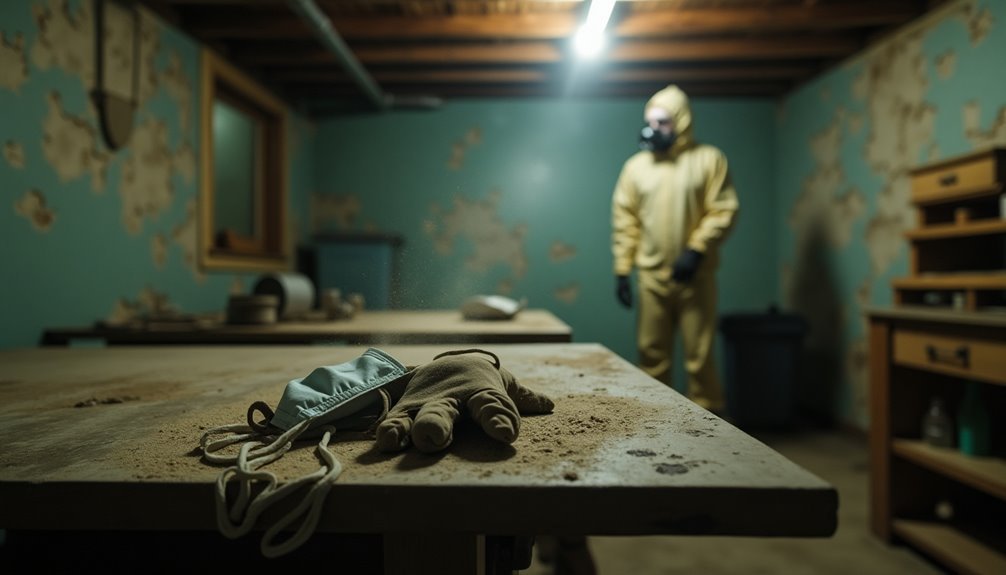
When considering DIY asbestos removal, it's vital to understand the serious health risks involved. Asbestos fibers can remain airborne for days after disturbance, significantly increasing your risk of inhalation. Once inhaled, these fibers can lodge deep within your lung tissue, leading to severe respiratory issues and potentially fatal diseases. Long-term exposure can result in asbestosis, a chronic lung disease characterized by lung scarring, along with an elevated risk of lung cancer and mesothelioma. All asbestos fibers are harmful if breathed, underscoring the importance of proper handling and removal.
You might not notice health symptoms immediately; they can take 20 to 60 years to develop and are often vague, such as coughing or shortness of breath. This delayed onset complicates matters, as early signs may not seem alarming enough to warrant immediate medical attention. Even small amounts of asbestos can lead to severe outcomes, making it essential to monitor your health closely after any known exposure.
Legal and Regulatory Challenges
When considering DIY asbestos removal, you must be aware of strict legal compliance requirements that can lead to hefty fines or even imprisonment for violations. Additionally, failing to adhere to these regulations opens you up to significant insurance liability risks. Understanding these challenges is crucial to avoid serious legal and financial repercussions. No safe level of asbestos exposure means that even minor oversights in handling could lead to irreversible health consequences.
Legal Compliance Requirements
Navigating the legal compliance requirements for asbestos removal can be daunting, especially since failure to adhere to established regulations can lead to significant penalties. You must follow strict notification procedures, such as informing the appropriate regulatory bodies at least seven days before beginning abatement activities. In New York City, for instance, even if there's no asbestos present, you'll need to submit notifications for demolition to the local DEP office.
Additionally, licensing requirements are crucial. Only licensed asbestos abatement contractors can perform removal tasks, and all personnel must be certified. A certified Asbestos Inspector is required to conduct a thorough survey to identify any asbestos-containing materials (ACMs) before work begins. Moreover, trained supervisors must be present at the site during abatement activities, and workers must engage in special procedures to prevent asbestos spread.
It's essential to comply with both federal and state regulations, including EPA's National Emission Standards for Hazardous Air Pollutants. Adhering to these legal frameworks protects public health and shields you from costly penalties related to non-compliance. Remember, each step you take in this process is integral to your safety and the safety of those around you.
Insurance Liability Risks
Understanding the legal compliance requirements for asbestos removal is only part of the equation; insurance liability risks also play a significant role in the overall process. Most homeowners aren't aware that standard insurance coverage typically excludes asbestos removal due to pollution clauses. This lack of coverage can lead to substantial financial liabilities if an exposure incident occurs.
| Aspect | Details |
|---|---|
| Insurance Coverage Exclusions | Most policies exclude asbestos removal and incidents. |
| Financial Risks | Homeowners may face tens of thousands in clean-up costs. |
| Lack of Protection | DIY efforts often leave homeowners uninsured. |
| Regulatory Penalties | Non-compliance can incur fines of $1,200-$10,000. |
If you engage in DIY asbestos removal, you risk bearing the full financial burden without any insurance protection. Additionally, compensation claims for health issues related to asbestos exposure can add to your financial woes. To avoid these daunting liabilities, it's crucial to hire licensed professionals who are equipped to manage asbestos safely and compliantly. After all, your liberation from asbestos hazards shouldn't come with the shackles of overwhelming financial burdens.
Importance of Training and Experience
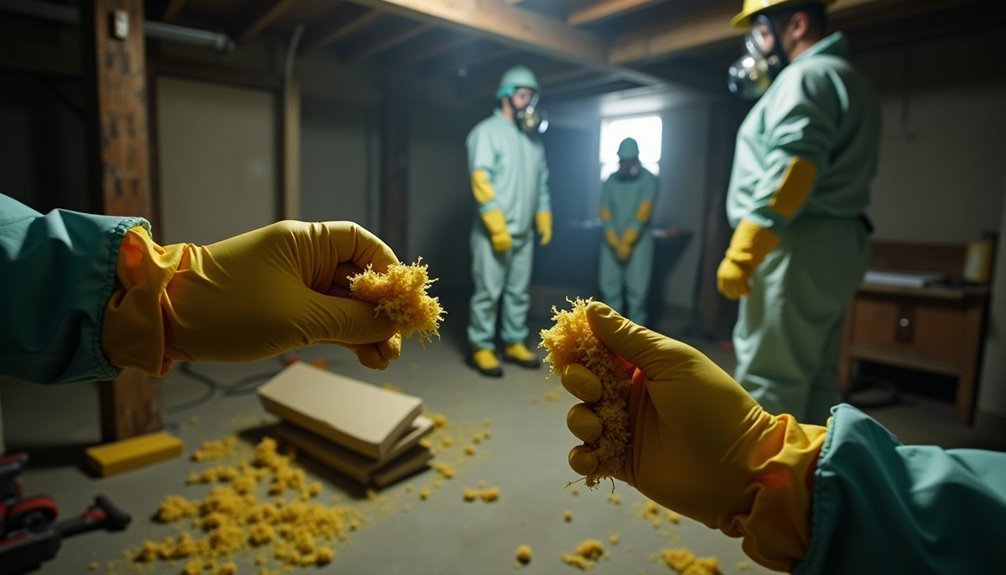
When dealing with asbestos, having the right training and experience is crucial. You need to accurately identify asbestos materials, employ safe removal techniques, and maintain awareness of regulatory compliance to protect yourself and others. Without this specialized knowledge, you risk exposing yourself to dangerous fibers and facing legal repercussions.
Identifying Asbestos Materials
Identifying asbestos materials requires specialized training and experience to ensure accurate detection and safe handling. You need to recognize various asbestos types and the identification techniques that reveal potential hotspots, like attic insulation, popcorn ceilings, and vinyl floor tiles. Professionals trained in asbestos detection are equipped to identify materials historically used in construction, particularly those from the 1940s to the early 1970s.
| Asbestos Type | Common Locations | Identification Techniques |
|---|---|---|
| Chrysotile (White Asbestos) | Insulation, roofing materials | Visual inspection, lab analysis |
| Amosite (Brown Asbestos) | Pipe insulation, ceiling tiles | Material sampling, polarized light microscopy |
| Crocidolite (Blue Asbestos) | Spray-on insulation, heat-resistant fabrics | Chemical testing, electron microscopy |
Understanding these aspects is vital to prevent damage to asbestos-containing materials (ACMs) and minimize the risk of fiber release. Skilled professionals know where to look and can safely manage the risks associated with disturbing ACMs during renovation. Their experience ensures compliance with regulations, preventing legal issues and protecting your health and environment.
Safe Removal Techniques
Safe removal of asbestos requires specialized training and experience to ensure both effectiveness and safety. You must understand asbestos regulations and the safe practices necessary to protect yourself and others. A proper containment strategy is vital; this involves erecting physical barriers and sealing the removal area with polyethene sheeting to prevent fiber escape. Regular inspections help maintain the integrity of this enclosure.
Specialized removal techniques, like wet removal, minimize fiber release by saturating asbestos-containing materials (ACMs) before handling. Avoid using power tools that can pulverize ACMs and instead utilize hand tools, removing materials in whole pieces to further reduce disturbance.
Personal protective equipment (PPE) is non-negotiable. You need respirators, coveralls, and gloves to safeguard against airborne fibers. Equally important is your training; comprehensive courses covering advanced removal techniques and decontamination procedures are essential. Practical exercises enhance your skills, ensuring preparedness for real scenarios. Certification must be renewed every three years, with periodic updates to stay compliant with health and safety guidelines. Emphasizing training and experience protects lives and ensures adherence to safe practices in asbestos removal.
Regulatory Compliance Awareness
Understanding the regulatory landscape surrounding asbestos removal is vital for anyone involved in this process. Federal regulations like the National Emission Standards for Hazardous Air Pollutants (NESHAP) mandate the identification of asbestos-containing materials (ACM) during demolition and renovation. Additionally, state regulations often require notifications to relevant authorities, such as in New York, where you must notify at least seven days in advance. Local regulations can add layers of complexity, emphasizing the need for awareness of regulatory updates.
Training and experience are critical compliance strategies that safeguard both your health and legal standing. Accredited training courses, lasting between two to five days, prepare you for handling asbestos safely, ensuring compliance with all levels of regulation. Achieving certification, which typically includes passing an exam, confirms your expertise and adherence to best practices.
Neglecting proper training can lead to severe legal and financial consequences, including hefty fines and potential environmental contamination. By prioritizing regulatory compliance, you not only protect yourself but also foster a safer environment for everyone. Engaging professionals for asbestos abatement ensures full compliance, liberating you from the burdens of legal ramifications and health risks.
Essential Safety Equipment
When tackling DIY asbestos removal, having the right safety equipment is crucial for protecting your health. You must adhere to asbestos regulations and follow strict safety protocols. Start with a proper respirator; a half-face or full-face filter respirator fitted with a class P1 or P2 filter cartridge is essential. Ensure it complies with Australian Standard AS1716, and maintain an airtight fit by being clean-shaven.
Next, wear disposable coveralls made from synthetic materials to block asbestos fibers. Avoid pockets and Velcro, which can trap particles. Use low-protein powder-free latex gloves and a disposable hat to minimize exposure. After the job, dispose of all clothing and gloves in specialized asbestos waste bags.
For your feet, opt for unlaced boots for easier decontamination, and reinforce them with airtight covers to prevent dust infiltration. Thick synthetic or leather gloves are ideal; they should be durable enough to resist tearing.
Finally, shower thoroughly after the job, including washing your hair, to eliminate any remaining fibers. Using HEPA vacuums and negative air pressure units will further help manage asbestos safely, just like professional abatement teams do.
Proper Disposal Practices
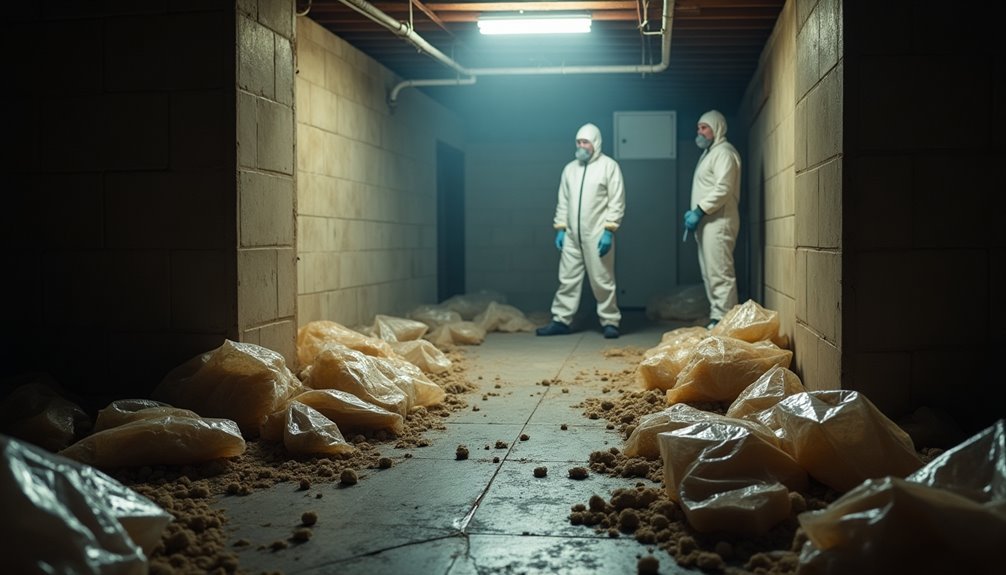
Proper disposal practices are vital after completing your DIY asbestos removal to prevent health risks associated with fiber release. You must first moisten the asbestos waste to minimize airborne fibers. Next, seal the wetted materials in two layers of 6-millimeter plastic bags, ensuring you maintain proper asbestos containment. Place these sealed bags into airtight, leak-tight containers with lids, and label them clearly to indicate they contain hazardous asbestos material.
When transporting, use vehicles that comply with state and federal regulations, which must also be labeled appropriately. Detailed shipment records are essential to track the asbestos-containing waste throughout its journey. Remember, not all landfills can accept asbestos waste; you need to ensure you're using a qualified landfill that meets strict protocols for handling and securing such hazardous materials.
Following all regulatory compliance measures is crucial. Notify the relevant state agency before any demolition or renovation, and ensure that any contractors involved are licensed. Adhering to these disposal methods not only protects your health but also contributes to public safety.
Environmental Impact of Asbestos
Asbestos poses significant environmental risks that extend far beyond the immediate area of disturbance. When released during construction, demolition, or improper disposal, asbestos fibers can lead to environmental contamination affecting air, water, and soil quality. These fibers can remain airborne for days, carried long distances by wind and water, contaminating areas far from the original source.
In the air, asbestos fibers can be inhaled, leading to both acute and chronic exposure risks. Higher concentrations can cause immediate health issues, while lower levels pose long-term dangers. The persistence of these fibers means that once they enter the air, they can linger and be redistributed from contaminated soil, further deteriorating air quality.
Water quality also suffers from asbestos contamination. If ingested, asbestos fibers present risks to digestive health, potentially linking to various cancers, although definitive evidence remains elusive. Additionally, soil contamination occurs when asbestos-containing materials are disturbed, posing long-term hazards as the fibers do not break down.
Understanding these environmental impacts emphasizes the importance of professional abatement. Only trained experts can manage asbestos properly, safeguarding both you and the environment.
Benefits of Professional Abatement
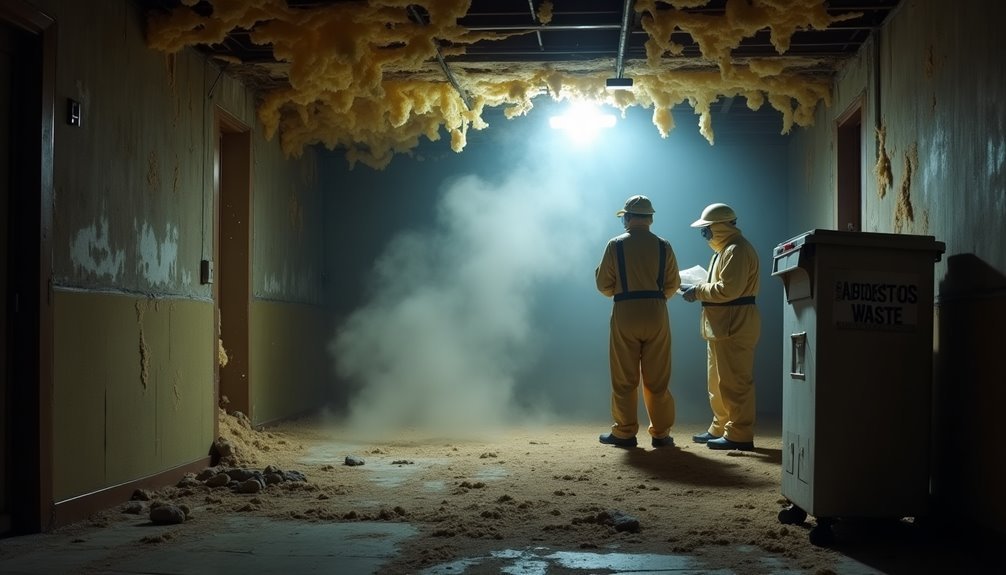
The environmental hazards associated with asbestos highlight the need for effective removal strategies. Engaging professional abatement services offers significant health and safety benefits, reducing the risk of asbestos-related diseases like lung cancer and mesothelioma. By eliminating the source of exposure, you protect not just yourself but also family, employees, and neighbors. Professionals conduct thorough risk assessments, ensuring that asbestos fibers aren't released into the air, which minimizes respiratory issues and creates a healthier environment.
Moreover, the financial advantages are substantial. You avoid potential fines and legal liabilities tied to non-compliance with regulations. Professional abatement enhances property value and marketability, safeguarding your investment. The peace of mind you gain, knowing your property is safe, far outweighs the costs associated with DIY methods.
Operational efficiency is another crucial aspect. Trained professionals utilize advanced equipment and adhere to strict safety protocols, minimizing disruption to your daily activities. Their expertise ensures proper containment and disposal of asbestos waste, while post-removal support, including air quality testing, guarantees that your space is safe for reoccupation. In this way, professional abatement not only safeguards health but also liberates you from future liabilities related to asbestos exposure.
Compliance With Regulations
Navigating compliance with asbestos regulations is crucial for any abatement project. You must stay informed about regulatory updates at both federal and state levels, as these can significantly impact your approach. The National Emission Standards for Hazardous Air Pollutants (NESHAP) set strict requirements, including notifying state agencies before demolition or renovation that may disturb asbestos-containing materials.
Implementing effective compliance strategies involves adhering to specific work practice standards to prevent the release of visible asbestos fibers. This includes ensuring that all personnel are trained and accredited according to EPA guidelines. You'll also need to secure necessary permits and submit notifications to local health departments, ensuring all documentation is meticulously recorded.
Regular inspections, including surprise checks, are common to verify compliance with these stringent regulations. Non-compliance can lead to significant fines and legal repercussions, making it essential to follow all performance standards and proper waste disposal protocols. By working with licensed asbestos contractors, you can alleviate the burden of navigating these complex regulations, ensuring safety for both the public and workers while maintaining compliance throughout the abatement process.
Enhancing Property Value
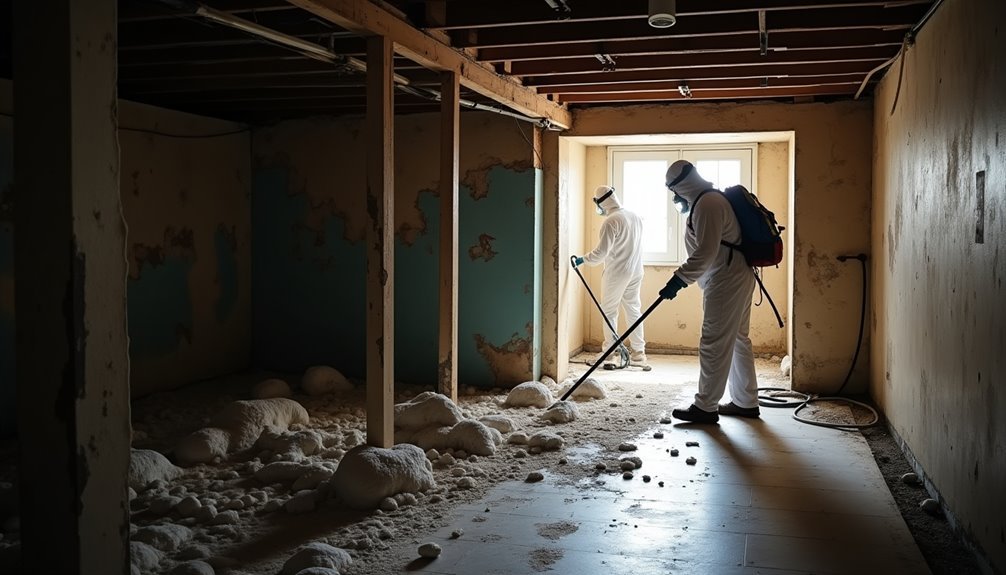
Successfully managing compliance with asbestos regulations not only ensures safety but also plays a significant role in enhancing property value. When you invest in professional asbestos removal, you address critical concerns that affect both the market competitiveness and property aesthetics of your home. Asbestos presence can deter potential buyers, leading to significant price reductions. By eliminating this hazard, you'll provide reassurance to buyers, making your property more attractive and valuable.
Consider these key benefits of professional asbestos removal:
- Complete Elimination: Professional services ensure total asbestos removal, enhancing safety.
- Increased Value: Properties without asbestos typically sell for 5-15% more than those with it.
- Buyer Confidence: Documentation of abatement can serve as leverage during negotiations.
- Long-Term Savings: Investing in removal now can prevent costly price reductions later.
Ultimately, professional abatement eliminates a major deterrent for buyers, allowing you to maintain or even increase your property's market value. Don't let asbestos jeopardize your investment; prioritize safety and aesthetics to truly enhance your property's appeal.
Conclusion
In the realm of home repair, tackling asbestos removal yourself is like navigating a treacherous forest without a map. Each step could lead to hidden dangers, jeopardizing your health and legal standing. By entrusting this task to trained professionals, you're not just ensuring safety; you're charting a course through the wilderness with expert guides. They possess the knowledge, equipment, and disposal methods to protect both you and your property, ultimately enhancing its value while safeguarding the environment.
